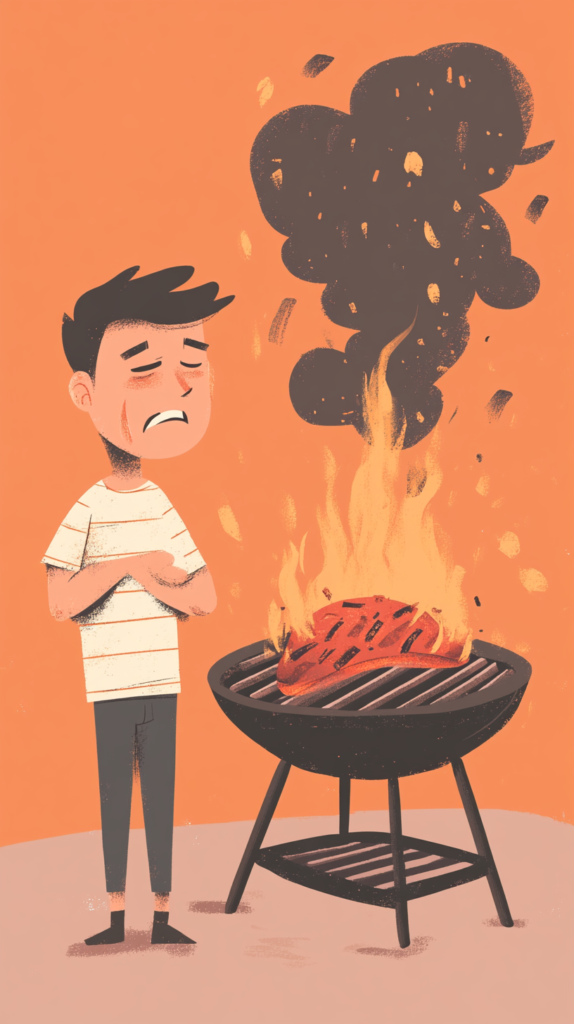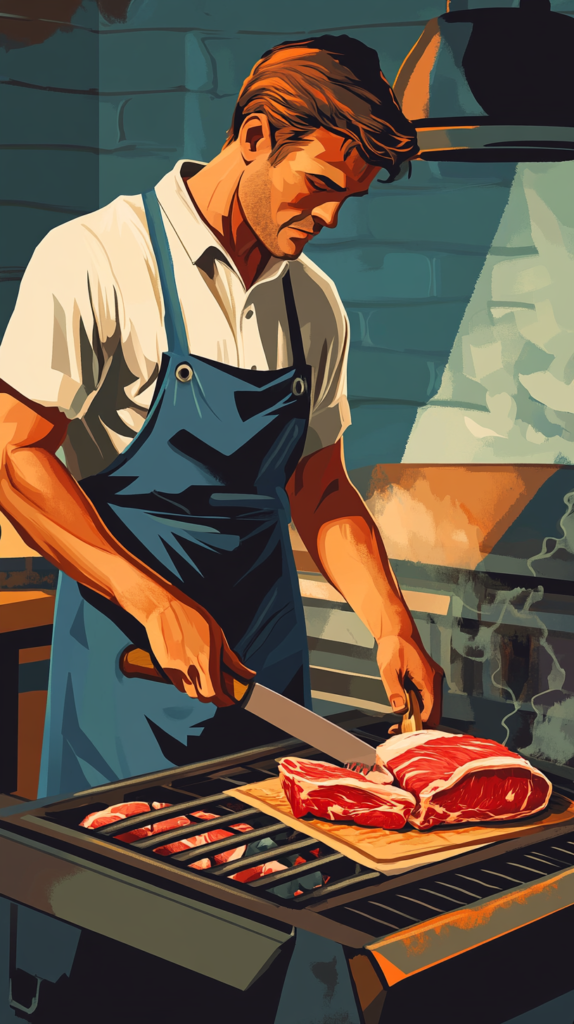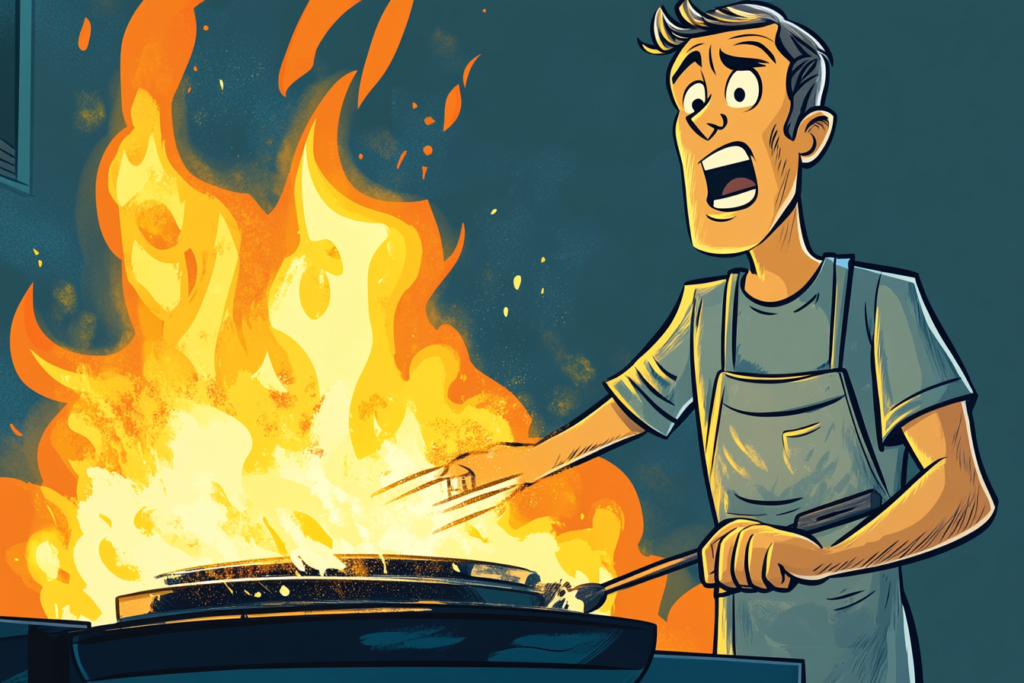Flare Up Happens: Introduction
Picture this: You’re grilling burgers on a sunny Saturday, enjoying the sizzle, when suddenly WHOOSH! A burst of flame shoots up, charring the edges of your perfectly shaped patties. We’ve all been there. A flare up. Those surprise flare-ups can turn a relaxing cookout into a frantic fire drill. I remember one of my early grilling adventures when a rogue flame singed more than just the burgers. That incident taught me to stay alert and manage those flames! The good news is that flare-ups don’t have to ruin your barbecue vibe. With a few simple techniques, you can keep the flames in check and cook your food evenly on the grill.
In this article, we’ll dive into why flare-ups happen and share practical tips to prevent them. From grease management to mastering heat zones (and everything in between), these tips will help you avoid sudden flare-up drama. Let’s get grilling – minus the fire-fighting!
What Causes a Grill Flare Up?

Flare-ups are those sudden flames that leap up when grilling, and the main culprit behind them is fat. When fat or oily marinades drip onto the hot burners or coals, they ignite and create a burst of fire. This often happens right after you place food on the grill or when you flip it, as that’s when juices drip the most. Even a gust of wind or leaving the lid open during a fatty steak sear can fan the flames higher
If you’re using a gas grill, you might notice fewer flare-ups compared to charcoal – gas grills usually have metal flame tamers or drip shields that deflect grease. But gas grills are not immune. Grease can still accumulate and eventually catch fire if not managed. In short, flare-ups are a normal part of grilling (especially with juicy burgers or chicken thighs), but too many or uncontrolled flames can burn your food and lead to uneven cooking. Understanding that it’s mostly the dripping fat causing the chaos is the first step to taming those flames.
Keep Your Grill Clean to Prevent a Flare Up
A clean grill is your first line of defense against flare-ups. Old grease and food bits are basically fuel waiting to ignite. If you’ve ever fired up a dirty grill, you know how old grease can flare up even before any fresh food goes on. I learned the hard way one spring that a grease-filled drip pan can quickly turn into a mini bonfire!
To avoid that, make grill cleaning a habit. Before each cook, give the grates a good scrub with a grill brush to remove charred residue. After grilling, once the grill has cooled slightly, scrape off any stuck-on bits so they don’t become kindling for next time. Also, check the grease catch-pan or drip tray under your gas grill – empty it regularly so accumulated fats don’t ignite
Many gas grills have flame tamers or heat plates over the burners (similar to Weber’s Flavorizer bars) to channel grease away, but those can get caked with grease too. Wipe down those shields or ceramic briquettes occasionally to clear out the gunk.
Don’t forget deeper cleaning now and then. Every so often (especially if you grill a lot), remove the grates and clean out the bottom of the firebox where grease and debris collect. Wipe out or replace foil drip pans. This kind of maintenance greatly reduces the chance of flare-ups. In fact, regularly cleaning your grill can significantly reduce the number of flare-ups you experience. It also helps your grill heat more evenly, since clean burners can do their job without blockage.
One extra tip: always preheat your grill fully before cooking. Preheating not only brings the grill up to temperature, but it also burns off many remnants from the last session. Starting with a clean, hot grate means fewer surprises from old grease catching fire. Plus, your food won’t stick as much to a hot, clean grate. A little upfront cleaning effort goes a long way to keep those unexpected flames at bay.
Trim Excess Fat and Manage Grease

Fat is the main cause of flare-ups. One of the best ways to prevent them is to trim excess fat from your foods. For example, trim the skin on chicken thighs or the thick fat cap on a steak. This gives the flames less fuel to feed on. You’ll still get delicious flavor, but with far less risk of towering infernos.
Marinades and oily sauces can also trigger flare-ups if they drip off. To prevent this, pat your marinated meats dry before they hit the grill. Wipe off excess marinade (especially if it’s oil-heavy) so it’s flavoring your food and not dripping into the fire. You can always brush more sauce on near the end of cooking, when flare-up risk is lower. The same goes for oiling food – a light coating is plenty. Too much oil will just drip off and ignite.
Another trick: use a drip pan when grilling really fatty cuts or doing long cooks like a rotisserie chicken. A simple aluminum pan under the grates catches melting fat before it hits the burners, preventing flare-ups at the source. This cuts down flames and makes cleanup easier.
Finally, be mindful when cooking juicy foods like burgers. Resist the urge to smash or press burgers with your spatula. That squeezes fat straight into the flames and causes immediate flare-ups. Likewise, avoid poking holes or stabbing your steaks and chops. Use tongs or a spatula to turn them gently. That way, those tasty juices stay in the meat rather than fueling the fire. By managing the grease on and around your food, you’ll tame those flare-ups and get more consistent, even cooking results.
Master the Flame: Heat Control and Zoning
Good heat control is key to cooking evenly and avoiding flare-ups. On a gas grill, you have the advantage of adjustable burners – use them wisely. Blasting all burners on high might sear a steak fast. But it also invites more flare-ups and can leave the inside undercooked. A better approach is to set up heat zones. Turn one burner (or one side of the grill) to medium-high and leave another burner on low or off. This creates a two-zone grilling environment: a hot direct heat side and a cooler indirect side. The idea is to always have a cooler zone where you can move food if things get too hot.
Using a two-zone setup is like having a safety net. Sear your burgers or steaks over the hot side. If you notice flames licking up, quickly shift the food to the cooler side until the fire calms down. On gas grills, it’s as simple as leaving one section of burners off to create that safe haven.
This not only prevents charring, but also helps thicker cuts cook through evenly without burning the exterior. For example, when grilling bone-in chicken or pork chops, start them on the high heat side to get a nice sear, then move them to indirect heat to finish cooking slowly. You’ll avoid the dreaded raw-inside, burnt-outside scenario.
Managing the lid is part of heat control too. Generally, keep the lid closed to maintain even heat (it turns your grill into an oven). If you see a flare-up starting, you have two options. Either move the food to the cool zone, or briefly close the lid to choke off the flame. Just a few seconds without oxygen will knock it down.
Never pour water on a grill flare (it won’t help and can splatter dangerously). Instead, trust your two-zone setup and stay calm. If a flame ever gets really out of hand, you can also turn off the burners until things settle.
By mastering two-zone grilling and keeping a watchful eye on your fire, you’ll cook with much more control. Your food gets a nice sear when it needs it, and a gentler heat when it needs to cook through. That means juicier, more evenly grilled results with way less stress.
Use the Right Tools for the Job
In grilling, having the right tools makes the job easier and safer. Use long-handled tongs and spatulas to keep your hands away from the heat.
Tongs also let you turn food without piercing it (unlike a fork), so juices stay in the meat and off the flames. Keep a sturdy grill brush on hand for cleaning grates; a quick brush before and after grilling prevents grease build-up that can lead to flare-ups. And use a meat thermometer to check if food is done instead of cutting into it (which would release juices and invite flare-ups). A little gadgetry goes a long way toward even cooking and fewer fire surprises.
Tips for Grilling Different Foods Evenly
Every food behaves a little differently on the grill. Here are some best practices to cook popular items evenly while avoiding flare-ups:
- Burgers: Use moderate heat and don’t overcrowd the grill. High-fat ground beef makes for juicy burgers but will drip more grease. That means more flare-ups, so have that cooler zone ready if flames spike. Never smash burgers with your spatula. It might be tempting, but you’ll squeeze out juices and cause flare-ups.
- Steaks: Start steaks on high heat to sear the outside, then finish on lower heat. Always pat the steak dry first to get a good crust. If flames rise up, move the steak to the indirect side for a moment until they settle. Thicker steaks really benefit from this two-zone method. After searing, move them to indirect heat to cook through evenly. This prevents the outside from burning before the center reaches your desired doneness. Also, trim any big chunks of fat from the edges of your steaks. This reduces dripping grease.
- Chicken (Poultry): Chicken with skin (thighs, drumsticks, wings) is notorious for causing flare-ups because fat from the skin melts and drips. Grill chicken pieces with skin over medium heat and try starting them on indirect heat first. Let the chicken cook most of the way through on the cooler side. This melts off a lot of the fat under the skin without constant fire. Then move it to the hot side at the end to crisp the skin and get a final char. This way you avoid chicken that’s burnt outside but still pink inside. If a flare-up happens under a piece of chicken, just move it away from the flame. Give it a moment until the flare subsides.
- Vegetables and Seafood: These have less fat, so flare-ups are rare, but you still want even heat. Brush veggies lightly with oil – too much oil will drip off and could flame up. Use a grill basket or skewers for smaller veggies or shrimp so they don’t fall through the grates. This also makes them easier to move if needed. For fish fillets, using foil or a cedar plank can protect them from direct flames while adding flavor. Grill veggies and seafood over medium heat and keep an eye on them; they tend to cook quickly, and you’ll get nice char marks without burning when you turn them promptly.
With these techniques in your toolbox, you’re ready to grill delicious meals without the flare-up drama. Fire up that grill and cook with confidence!
Grilling can be dangerous. Always follow proper food safety guidelines when handling and cooking meat. Use a meat thermometer to ensure safe internal temperatures, wash hands and surfaces thoroughly, and avoid cross-contamination. Information is provided for educational purposes only.
Some posts may contain affiliate links. If you purchase through these links, we may earn a small commission at no cost to you.
